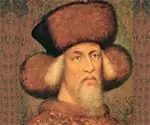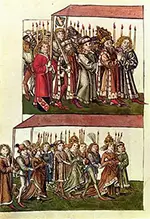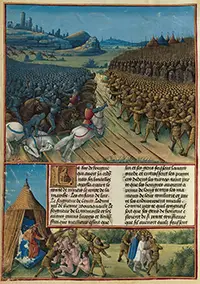Sigismund: King of Germany, Holy Roman Emperor
Sigismund was Holy Roman Emperor and King of Germany for a time in the early 15th Century. He played a role in ending the Catholic Church's Great Schism. 
He was born on Feb. 15, 1368, in Nuremberg. His father was the reigning Holy Roman Emperor, Charles IV, and his mother was Elizabeth of Pomerania. Sigismund went early in life to the Hungarian court. He embraced his new country as his homeland and won the respect and accolades of King Louis the Great of Hungary and Poland, not least because the youth learned French, German, Hungarian, Italian, and Latin. That king had betrothed his daughter Mary to Sigismund when the latter was just 6; he later named the youth as his heir apparent. Sigismund's older brother, Wenceslaus IV, succeeded their father as King of Germany in 1378, along about the time that Sigismund went to live at the Hungarian court. King Wenceslaus sent his brother to Poland to try to improve relations there. Sigismund had much influence in Poland but was unsuccessful at gaining the Polish crown, which was up for grabs after the death of King Louis, in 1382. In the meantime, Sigismund married Mary and the pair were later Sigismund increased his prestige and reputation in 1396 by leading a very large army into battle against Turkey, which had absorbed some of Hungary. The ensuing struggle at the Battle of Nicopolis, in September 1396, resulted in a sharp Turkish victory. Sigismund had wanted to win a great victory in order to press his claim for rule in Hungary; the defeat ruined those chances. Sigismund's wife, Mary, had died in 1395, shortly after giving birth to a son who died as well. Nine years later, he married her cousin, Barbara of Celje. She had a daughter, Elisabeth, in 1409. Sigismund expanded his holdings into what is now Croatia, claiming the kingship there, making alliances with some peoples there and at the expense of others. He founded his own personal order of knights, known as the Order of the Dragon. 
As was the case with many monarchs in medieval Germany, Wenceslaus owed his crown to the support of other powerful nobles. One of those was his cousin Jobst, who, in turn, rebelled against Wenceslaus and had him deposed as King of Germany. The next monarch was Rupert, who died in 1410. Succeeding him was Jobst. When that king died suddenly, in January 1411, Sigismund, who had just missed out on becoming king, stepped into the void and took the crown. He was elected on July 21, 1411. The newly crowned King of the Romans spent the next few years attacking Poland, under an alliance with the Teutonic Knights. He also played a major part in ending the Great Schism, a huge argument within the Catholic Church that had resulted in two sets of popes, one in Avignon and the other in Rome. Sigismund helped bring all parties together at the Council of Constance, a four-year series of meetings that resulted in the abdication of the rival popes and the declaration of just one new one. The German king signed a treaty with England's King Henry V in 1416. The resulting alliance against France was more formulaic than practical but did help to end the Great Schism. 
One result of the end of the religious struggle was the death of the prominent reformer Jan Hus. Many sources say that Sigismund had guaranteed Hus safe passage to and from the meeting that healed the Catholic schism; however, Hus was captured nonetheless and executed. His supporters fanned the flames of revolt, and Bohemia and surrounding lands were consumed in a handful of wars for the next few decades. The monarch proved powerless to stop the fighting, and his forces lost a number of skirmishes and a lot of prestige. He went to Milan in 1431 and was crowned King of Italy. Two years later, in Rome, he accepted the crown of the Holy Roman Emperor. The pope who crowned him, Eugenius IV, prodded Sigismund to again fight against the Ottoman Turks; those efforts came to naught. Sigismund was in Znojomo, Moravia, when he died, on Dec. 9, 1437. He had no sons, so the House of Luxembourg died with him. His daughter had married Albert, Duke of Austria, and Sigismund had designated Albert as his successor. |
|
Social Studies for Kids
copyright 2002–2026
David White



 named King and Queen of Hungary. They had to defend their realm from an invasion by Charles III of Naples, but they did so, in part because of help from Wenceslaus and his army. The resulting death of Charles III only slightly diminished the struggle against Naples.
named King and Queen of Hungary. They had to defend their realm from an invasion by Charles III of Naples, but they did so, in part because of help from Wenceslaus and his army. The resulting death of Charles III only slightly diminished the struggle against Naples.
